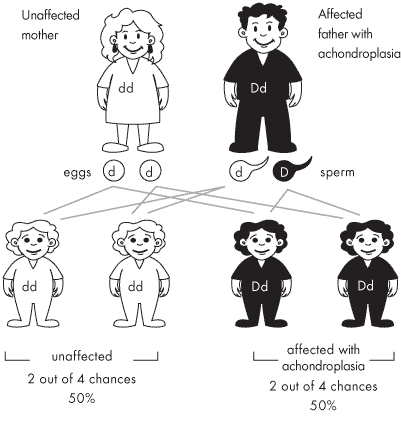Achondroplasia is one of a group of disorders called chondrodystrophies or osteochondrodysplasias, in which growth hormones that deal with cartiledge are dibilitated or absent completely. It may be inherited as an autosomal dominant trait, which means that if a child gets the defective gene from one parent, the child will have the disorder. If one parent has achondroplasia, there is a 50/50 chance of the child inheriting the disorder (shown in left diagram). If both parents have the condition, the child's chances of being affected increase to 75%, with one of the 3 affected children severely affected and likely to die at infancy (show in right diagram). However, often times two parents without the gene may produce an inflicted infant through a genetic mutation.


Achondroplasia is caused by a mutation of the fibroblast growth factor receptor 3 gene. This gene's loci is on the 4th, at position 16.3 chromosome. This gene controls the growth rate of the humerus and femur. However, when a mutation occurs, the ability of the bone to grow becomes extremely limited. Instead of producing the correct amino acid, it produces another.

Back to Home Page
Comments (1)
Jacob Halbert said
at 10:28 am on Nov 4, 2009
i like the pictures of the chromosome and the probabliities of the children because this show how this disorder can be passed off to children.
You don't have permission to comment on this page.